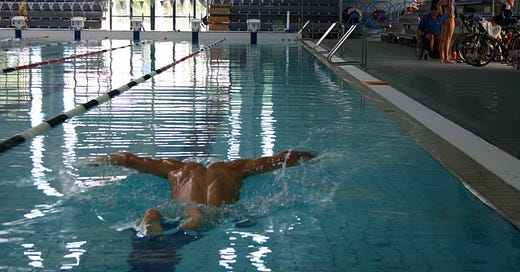98% of what I do in my training falls into the bucket of Strength & Endurance.
Here are my favorite “strength” sessions by sport.
Thinking back to our triangle of performance, these sessions focus more on Force-Endurance. They are complementary to the Force-Skill sessions shared by John.
I love these sessions because you can do them on effort and there is no pace pressure. They can be scheduled across a range of fatigue states and accumulate a lot of work.
Medley 250s
This is a swim that’s best done in a short course pool (25 meter or 25 yard).1
The pattern is 100 Medley / 150 Free:
Medley is done by 25, Fly-Back-Breast-Free
The Free is meant to be active recovery - OK to use a pull buoy if that’s required to get your heart rate down.
Don’t rest between the 100 Medley and the 150 Free. If you need rest before the next 250 (to be able to swim 25 Fly) then take as much as you need.
Skilled, and well-trained, swimmers will be able to “Flip into Fly” and do the entire set continuous.
Total main set length is 1000 to 5000 of swimming. 2000 is a good dose for a Competitive Amateur.
My three favorite warm-ups for this swim. Choose One.
No-warm-up warm-up => dive in and get rolling.
400 Easy with every 4th 25 non-free, 4x100 descend2 1-4 on 10s rest, 4x50 alt Build/Easy by 25 on 10s rest.
8-12 x 50; odds long & strong / evens relaxed on 10s rest.
This is “just do it” swimming. The benefit comes from doing the workout. No need to smash yourself.
Coach Hellemans On Medley & Fly
When using medley followed by freestyle. To make this a pure strength endurance exercise, an athlete can do 25-50 meters of fly, followed immediately (no rest) by 100-150 meters of freestyle (so start the freestyle really fatigued). The breast and back in the medley allow for recovery (possibly “too much” for an experienced swimmer).
Fly in itself is an excellent strength-endurance stroke for triathletes. Age groupers dislike it as they often have technical difficulties. I encourage them to work on it, with help from a swim coach if necessary. Over time, fly will really help their freestyle.
Scott Molina inserts vertical push-ups and the end of the pool in between his reps.
Big Ring Only
Simple But Effective - ride a rolling course in your big ring. Keep your heart rate in your Green Zone (Easy/Steady - Zone 1/2). Learn to relax and focus on smooth transfer of power. Finish the ride with 20-60 minutes, holding a cadence of 88-92 rpm, using the small ring, Easy Effort.
Big Ring Endurance Climbs - as you become “stronger” you’ll be able to ride long moderate climbs in your big ring, while keeping heart rate in your Green Zone. Balance the low cadence climbing with higher cadence (90+ rpm) when you are descending.
Big Ring Builds - as you become even “stronger” you’ll be able to insert 1-2 km sections where you build effort to a Moderately-Hard heart rate (Zone 3), and keep cadence not more than 65 rpm. Alternate these Big Ring Builds with similar duration blocks of Steady effort (Zone 2 heart rate) and choice cadence.
Non-Drafting Triathletes & TT-specialists - perform these sets on the TT Bike, in TT Position.
Build specific fitness in the position you will be racing.
Duration: the “strength” ride should be programmed as the second longest ride in the week. For triathletes, it is an effective part of a race-specific combination session (bike-run).
Running Durability
Directly target your durability by running in rolling terrain. The purpose of this session is to rack up elevation change (both up and down).
When climbing, stay tall, keep heart rate moderate (Zone 3 cap), shorten stride to reduce heart rate spiking.
When descending, stay relaxed, let heart rate fall, lift cadence and stay smooth.3
The appropriate grade for this kind of work will vary with athlete fitness. I like old railway trails, a gradual grade is perfect for this kind of work.
Fatigue should be coming from duration and elevation change, not effort.
If using hills in a long run then valuable data can be gathered by ending the run with a 5 to 10 km benchmark set. This set can be done at LT1 Pace (Easy/Steady), Tempo Pace (Zone 3) or Core Pace for an up-coming race.
Back to Table of Contents
SCM = short course meters, 25m; SCY = short course yards, 25yds; LCM = long course meters. 50m.
Descend = each interval faster than the prior one. Build = gradually faster inside the interval.
Let Heart Rate Fall Downhill - each time I’ve ignored this advice, I’ve regretted it. For most everyone, high heart rate, downhill running should be saved for race day. Downhill running benefits durability at every speed.





